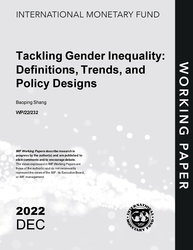
Tackling Gender Inequality: Definitions, Trends, and Policy Designs
Tackling Gender Inequality: Definitions, Trends, and Policy Designs
READ MORE...
Volume/Issue:
Volume 2022
Issue 232
Publication date: December 2022
ISBN: 9798400224843
$20.00
Add to Cart by clicking price of the language and format you'd like to purchase
Available Languages and Formats
| English |
Prices in red indicate formats that are not yet available but are forthcoming.
Topics covered in this book
This title contains information about the following subjects.
Click on a subject if you would like to see other titles with the same subjects.
Economics- Macroeconomics , Economics / General , Gender Studies , gender inequality , gender gaps , allocative efficiency , targeted gender policies , targeted gender policy , gender inequity , policy challenge , gender wage gap , Policy design
Also of interest
Summary
This paper identifies five key issues that are important for the continued efforts to tackle gender inequality: (i) gender inequality needs to be distinguished from gender gaps. Not all gender gaps necessarily reflect gender inequality as some gender gaps are not driven by the lack of equal rights, responsibilities and opportunities bywomen and girls, and this has important implications on policy designs to address gender inequity. However, the literature has paid little attention to this issue, often using gender inequality and gender gaps interchangeably; (ii) the evolving focus of gender inequality suggests there is still a long way to go to fully address gender inequality. Particularly gender inequality is taking more subtle and implicit forms, though the social and economic benefits from addressing the remaininggender inequality is still likely to be substantial; (iii) addressing gender inequality benefits everyone, not just women. Thus, the entire society should work together, even for each individual’s own interest; (iv) both general policies and targeted gender policies can help address gender inequality.However, as gender inequality becomes more subtle and implicit, targeted gender policies will likely need to play an increasing role, which also makes separating gender inequality from gender gaps all that more important; and (v) addressing gender inequality does not need to start with policies targeted at its root causes, but needs to end with eliminating the root causes. Only then, any remaining gender gaps would only reflect preference and comparative advantage between men and women. The paper concludes by discussing gaps in the literature and policy challenges going forward.
Copyright © 2010 - 2026
Powered by:
AIDC



